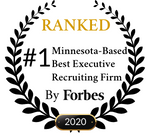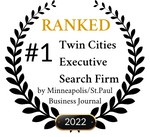Recruiting within the legal field is a deeply nuanced profession. When your firm or corporate legal department is hiring, you’re seeking more in a candidate than the required legal credentials. You’re seeking an individual who can embrace your organization's values, clientele, and approach. Legal recruiters play a central role in bringing that talent to you. But to be credible in this industry, being a very successful general practice executive recruiter simply isn’t enough. A legal recruiter needs to bring their in-depth, personal experience in the legal field - and the degree to prove it.
Why You Should Choose a Legal Recruiter with Legal Experience
At 14% of Minnesota’s total GPD, manufacturing is its largest private sector element, according to a recent article. The sector currently employs one in seven people living in Minnesota, equating to approximately 306,000 and supports jobs in other sectors. Directly or indirectly, manufacturing supports a third of all Minnesota jobs.
...And how a recruiter can help facilitate this process.
Navigating the Talent Shortage in Supply Chain: Tips for Hiring Top Professionals
A 2022 report from the Association for Supply Chain Management (ASCM) revealed that 79% of supply chain organizations struggle to find qualified talent to fill key roles. This talent shortage is fueled by a combination of factors, including the aging workforce, a lack of awareness about supply chain careers, and the increasingly complex skill sets required for roles in this field.
Honoring Our Veterans: Why Hiring Veterans Benefits Everyone
This Veterans Day, we’re reminded of the courage, resilience, and dedication that our nation’s veterans have demonstrated in serving our country. For their bravery and commitment, veterans deserve not only our gratitude but our support as they transition back into civilian life. One of the best ways we can honor their service is by offering meaningful career opportunities.
Veterans bring a wide array of skills and qualities that enrich the workplace. Their military experience instills values like discipline, teamwork, adaptability, and the ability to perform under pressure—traits that translate seamlessly to many industries. By hiring veterans, organizations can tap into a unique and highly skilled talent pool, while veterans benefit from a supportive environment where their skills and dedication are appreciated and put to valuable use.
Why Hire Veterans?
-
Unmatched Leadership Skills: Veterans are often trained to lead by example, make tough decisions, and inspire others, even in challenging situations. Their ability to manage, motivate, and guide a team is a powerful asset to any organization.
-
Commitment to Mission: Military personnel are accustomed to prioritizing the mission. This commitment to purpose and the ability to work with determination align well with corporate goals and can drive long-term success.
-
Problem-Solving Abilities: Service members encounter unpredictable challenges that require fast, creative, and effective problem-solving. They are skilled at adapting to changing situations—whether in combat or logistics—and bring that quick thinking to the workplace.
-
Diverse Skill Sets: The military trains individuals in various technical and interpersonal skills, from cybersecurity and engineering to logistics and medical care. Veterans have valuable expertise that is relevant across many sectors.
-
Resilience and Reliability: Veterans are resilient and accustomed to handling stress. They understand responsibility and accountability, which can be a stabilizing presence in any team.
Ways to Support Veteran Hiring
-
Create Veteran-Friendly Job Postings: Highlight specific qualities or certifications that veterans may have. This can help veterans see how their experience aligns with the role.
-
Offer Training Programs: Transition training or upskilling programs can help veterans adjust more easily to civilian job roles. Mentorship programs are also an excellent way to support them as they settle in their new environment.
-
Connect with Veteran Support Organizations: Several organizations, including Hiring Our Heroes and Veterans’ Employment and Training Service (VETS), are dedicated to helping veterans find work. Partnering with these organizations can make your hiring process smoother and more impactful.
-
Value Diversity of Experience: Veterans bring a unique perspective that can contribute to diversity and inclusion efforts within your company. Recognizing and valuing these experiences makes for a richer workplace culture.
Hiring veterans is not just a way to say “thank you” but a smart investment that can strengthen any organization. This Veterans Day, let’s show our appreciation not just in words but in action by creating opportunities that welcome our service members back into the workforce. They have served us well; now, let’s do our part to serve them.
To all veterans: we honor you, we thank you, and we support you.
Celebrating Independence Day as a US Employer
July 4th, Independence Day, holds a special place in the hearts of those who live in the United States. It is a federal holiday celebrated with patriotic displays, fireworks, barbecues, and more. Whether you consider yourself patriotic or not, there's a good chance you still appreciate the chance to enjoy the summer and recharge for a day. Here are some things to consider as a US Employer.
IT Recruitment: What Hiring Managers Need to Know in 2024
At SkyWater Search Partners, we specialize in recruiting for multiple disciplines, each led by industry experts. including the fast-paced, constantly changing IT sector. Here’s our take on current trends affecting the IT sector and our advice to hiring managers seeking top talent in 2024:
Offer The Market Rate Or Your Talent Acquisition Strategy Will Flop
Unemployment rates are low which means hiring (and retaining) talent must be a priority.
Hiring managers may claim they want to attract the best candidates to their brand, yet they are stifled in their ability to do so by what we call ‘internal equity’. This problem typically occurs when the hiring manager fails to hire an outstanding candidate because they can’t meet their salary expectations of $120k as the equivalent manager in the next department is only earning $100k. The result is that the employer makes an unsatisfactory offer to the candidate their business desperately needs. The candidate turns the offer down and is swiftly employed by a competitor willing to meet their salary expectations.
Job Description Mistakes that Repel Great Candidates and How to Fix Them
“There just aren’t any great candidates out there right now.” I hear it all the time, usually from battle-weary hiring managers. They’ve taken the time to craft a solid job posting, only to watch a handful of not-quite-right resumes trickle into the system. While it’s true that, depending on your industry and the role you’re attempting to fill, talent is still painfully scarce. But before you blame the lack of candidates, I have a question for you to consider:
Hiring? I Have a Question for You this Veterans Day
Have you checked your own perceptions of "Military Skills" lately?
Recently, I read a report for CBS News by Norah O’Donnell and Olivia Rinaldi highlighting an issue that has confounded me for years: the underemployment of military veterans. Even today, as so many employers struggle to attract, hire, and retain talent, these extraordinarily qualified individuals continue to be overlooked.
















